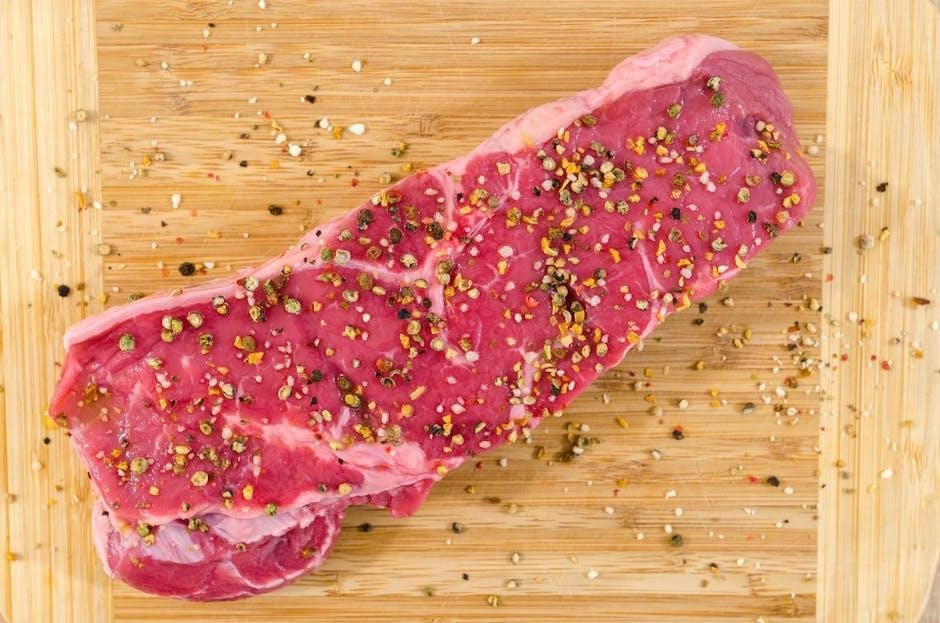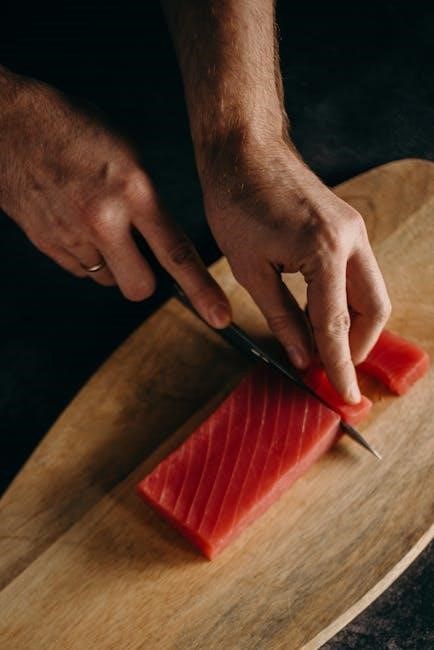Butchery is the ancient craft of preparing and cutting meat, requiring skill, precision, and a deep understanding of animal anatomy and meat science. From primal cuts to
artisanal presentations, butchery plays a vital role in transforming raw ingredients into culinary delights, preserving tradition while embracing innovation for modern tastes and sustainable practices.
The Role of a Butcher in the Modern Food Industry
A butcher is a skilled professional connecting consumers with high-quality meats, ensuring ethical sourcing, and maintaining food safety. They bridge the gap between producers and consumers, offering expertise in cutting, trimming, and presenting meats. Butchers play a crucial role in preserving culinary traditions while adapting to modern demands for sustainability and transparency in the food supply chain.
Tools and Equipment for Butchery
Essential tools include sharp knives, meat grinders, sausage stuffers, and cleavers. Specialized equipment like bandsaws and tenderizers enhance efficiency. Proper storage and hygiene ensure quality and safety.
Essential Knives and Cutting Tools
A butcher’s arsenal includes a chef’s knife for precision, a boning knife for deboning, and a fillet knife for delicate cuts. A cleaver is used for splitting bones, while sharpening steels maintain edge quality. Proper knife care ensures longevity and safety, making them indispensable tools in the trade.
Meat Grinders and Sausage Stuffers
Meat grinders and sausage stuffers are essential tools in butchery, enabling the preparation of ground meats and sausages. Grinders process raw meat into uniform textures, while stuffers precisely fill casings. Available in manual or electric models, they cater to various scales of production, ensuring consistency and quality in creating custom sausages and other meat products.
Other Key Equipment for a Butcher’s Shop
Besides grinders and knives, butcher shops rely on saws for cutting bones, cleavers for splitting meat, and sharpening tools to maintain blade precision. Vacuum packagers extend shelf life, while scales ensure accurate portioning. Display cases showcase products attractively, and refrigeration units maintain freshness, completing the essential setup for efficient and sanitary meat preparation.

Basic Cutting Techniques
Mastering foundational cutting skills like slicing, chopping, and trimming is crucial for precision and consistency. These techniques ensure uniform portions, enhance meat quality, and improve presentation.
Understanding Different Cuts of Meat
Recognizing various meat cuts, such as primal, sub-primals, and retail cuts, is essential for butchers. Each cut varies in tenderness, flavor, and best-use cooking methods, ensuring optimal quality and customer satisfaction. Proper identification and selection of cuts enhance culinary versatility and meet specific dietary preferences, making it a cornerstone of skilled butchery.
How to Properly Trim and Debone Meat
Trimming and deboning require precision and skill to remove excess fat and bones without wasting meat. Using a sharp boning knife, carefully cut around bones and cartilage, ensuring clean separation. Proper technique prevents waste and enhances the quality of the final product, while maintaining hygiene standards to ensure safety and freshness.
Portion Control and Precision Cutting
Portion control ensures consistent meat sizes for cooking. Precision cutting requires sharp tools and skilled technique. Clean, accurate cuts enhance quality and presentation. Proper trimming and slicing prevent waste, ensuring each portion meets high standards. This step is crucial for both home cooks and professional chefs, emphasizing efficiency and customer satisfaction in each cut.

Meat Selection and Quality
Selecting high-quality meat involves understanding factors like fat marbling, color, and texture. A skilled butcher evaluates these traits to ensure optimal flavor and tenderness, sourcing from reputable, sustainable farms.
How to Choose the Freshest and Best Quality Meats
When selecting meat, look for vibrant color, firm texture, and a fresh, clean smell. Opt for cuts with even fat distribution for better flavor and tenderness. Ensure the meat is sourced from reputable farms, with clear labeling and certifications. Avoid packages with excessive liquid or discoloration, as these indicate spoilage.
Understanding Meat Grades and Labels
Meat grades indicate quality, with factors like marbling, tenderness, and maturity. Labels like “organic” or “grass-fed” signify production methods. Look for certifications from trusted organizations, ensuring ethical and sustainable practices. These labels help consumers make informed choices about taste, texture, and environmental impact, guiding decisions aligned with personal preferences and values.
The Importance of Sustainability in Meat Sourcing
Sustainability in meat sourcing ensures ethical practices, reducing environmental impact and promoting animal welfare. It supports local economies, preserves biodiversity, and enhances food security. Consumers increasingly demand traceable, eco-friendly products, driving butchers to adopt responsible sourcing methods that balance quality, ethics, and environmental stewardship for a healthier planet and future generations.

Cooking Methods for Butchered Meats
Cooking butchered meats involves techniques like roasting, grilling, and pan-frying to enhance flavor and texture. Proper cooking methods ensure meat is cooked to safe temperatures while retaining juiciness and flavor, making it a culinary delight for any dish.
Roasting, Grilling, and Pan-Frying Techniques
Roasting enhances meat’s natural flavors, requiring precise temperature control for even cooking. Grilling adds smoky notes, ideal for steaks and chops, while pan-frying achieves a crispy crust. Each method demands proper seasoning and timing to ensure tender, flavorful results. Using marinades or rubs can elevate the dish, while tools like meat thermometers ensure perfect doneness every time.
How to Cook Different Types of Meat to Perfection
Cooking meat perfectly requires understanding its type and ideal techniques. Red meats like steak thrive at medium-rare, while poultry needs thorough cooking. Fish should be flaky but tender. Use marinades for flavor enhancement, and always let meat rest. Precision with thermometers ensures doneness, avoiding overcooking and maintaining juiciness across all cuts and varieties;
Marinades, Rubs, and Seasonings for Enhanced Flavor
Marinades, rubs, and seasonings elevate meat’s flavor. Acidic marinades tenderize, while rubs add bold spices. Seasonings enhance natural taste. Herbs, garlic, and spices create depth. Timing is key: marinate for hours, season just before cooking. These techniques ensure rich, complex flavors, transforming butchered meats into culinary masterpieces with precision and creativity;

Safety and Hygiene in Butchery
Proper handwashing, protective gear, and clean tools are essential. Correct storage prevents contamination, ensuring meat safety and quality. Regular sanitation maintains a hygienic environment for processing.
Proper Handling and Storage of Meat
Meat must be handled gently to avoid bruising and stored at consistent refrigerated temperatures to prevent bacterial growth. Use airtight packaging to maintain freshness and prevent contamination. Regularly check stored products for spoilage. Label and date items for easy rotation. Cleanliness during storage is essential for ensuring food safety and quality.
Sanitation Practices in the Butcher Shop
Sanitation is critical in a butcher shop to prevent contamination and ensure food safety; Implement strict cleaning schedules, sanitize all surfaces, and maintain proper waste disposal. Employees must wash hands frequently and wear protective gear. Regularly inspect equipment and storage areas to uphold hygiene standards and comply with food safety regulations.
Food Safety Regulations and Compliance
Adhering to food safety regulations is essential for butchers to ensure consumer health and business integrity. Key practices include maintaining proper temperature controls, preventing cross-contamination, and ensuring accurate labeling. Regular audits, staff training, and record-keeping are crucial for compliance. These standards protect both customers and the business, fostering trust and legal adherence in the industry.

Common Mistakes to Avoid
Common mistakes in butchery include overworking meat, leading to toughness, and improper storage, which can cause spoilage. Additionally, neglecting proper hygiene practices can result in contamination.
- Overhandling meat during cutting or grinding.
- Incorrect temperature control for meat storage.
- Poor sanitation, leading to cross-contamination risks.
Overworking the Meat and Other Cutting Errors
Overworking meat can lead to toughness and loss of natural juices, while improper cutting techniques may result in uneven portions or wasted material. Common errors include using dull knives, applying excessive pressure, and cutting against the grain. These mistakes can compromise both the quality and presentation of the final product, reducing its appeal and value.
- Incorrect knife angle or strokes during trimming.
- Insufficient removal of connective tissue or fat.
- Failure to align cuts with muscle fibers.
Incorrect Storage and Handling Practices
Improper storage and handling can lead to contamination, spoilage, and safety risks. Storing meat at incorrect temperatures or in inadequate packaging allows bacteria to grow. Cross-contamination occurs when raw and cooked meats are not separated. Neglecting to rotate stock or exceeding sell-by dates can result in wasted product and potential health hazards.
- Not maintaining consistent refrigeration below 40°F (4°C).
- Using damaged or non-food-grade packaging materials.
- Failing to label and date stored meats clearly.
How to Avoid Cross-Contamination
To prevent cross-contamination, use separate cutting boards, knives, and utensils for raw and cooked meats. Wash hands thoroughly before and after handling meat. Sanitize all tools and surfaces with approved cleaners. Store raw meats in sealed containers to avoid juices from coming into contact with ready-to-eat foods.
- Use color-coded tools for different meat types.
- Sanitize frequently between tasks.

Advanced Butchery Techniques
Advanced butchery involves mastering curing, smoking, and precise cutting for unique textures and flavors. These techniques demand skill and creativity to elevate meat preparation and presentation.
Curing and Smoking Meats
Curing and smoking meats are advanced techniques that preserve and enhance flavor. Curing involves using salt and sugar to draw moisture and prevent spoilage, while smoking adds rich, complex flavors. Proper temperature and humidity control are crucial for safety and quality. Popular methods include dry-curing for prosciutto and hot-smoking for tender, flavorful BBQ brisket.
How to Make Sausages at Home
Making sausages at home involves grinding meat, mixing with seasonings, and stuffing into casings. Select fresh, high-quality ingredients and ensure meats are chilled. Use a meat grinder for consistent texture, then mix thoroughly with spices. Stuff the mixture into natural or synthetic casings using a sausage stuffer. Twist into links and cook to an internal temperature of 160°F for safety.
Preparing and Cooking Offal
Offal, such as liver, kidneys, and tongue, requires careful preparation. Clean and trim organs, soaking in vinegar or milk to reduce bitterness. Cook gently, as overcooking can make them tough. Roast, fry, or braise for tender results. Pair with spices, herbs, or marinades to enhance flavor. Proper handling ensures a delicious, nutritious dish.

The Art of Butchery
The art of butchery combines centuries-old techniques with modern creativity, transforming raw ingredients into culinary masterpieces. It balances tradition, innovation, and a pride in craftsmanship, connecting cultures through food.
Historical Evolution of Butchery Practices
Butchery dates back to ancient times, with early humans using stone tools for meat preparation. Metal tools emerged in civilizations like Egypt and Rome, refining techniques. The Middle Ages saw guilds standardizing practices, while the Industrial Revolution introduced mechanical grinders and refrigeration. Modern butchery blends tradition with sustainability, preserving heritage while adapting to contemporary tastes and ethical standards.
Cultural Influences on Meat Preparation
Meat preparation reflects diverse cultural traditions, with techniques like Asian slicing for stir-fries, European roasting, and Middle Eastern spicing. Regional preferences, such as Japanese precision cutting or Latin American grilling, highlight how cultural heritage shapes butchery. These practices, passed through generations, enrich global cuisine with unique flavors and methods, celebrating local tastes and traditions.
Innovative Trends in Modern Butchery
Modern butchery embraces sustainability, precision, and creativity. Ethically sourced meats, plant-based alternatives, and automated cutting tools are gaining popularity. Artisanal techniques blend with technology, such as AI-driven inventory systems. Experiential retail, like interactive workshops, enhances customer engagement. These trends reflect a shift toward transparency, efficiency, and catering to diverse dietary preferences, revolutionizing the craft for contemporary consumers.

Resources for Further Learning
Explore books, online courses, and workshops for in-depth knowledge. Join butchery communities and forums for expert insights and hands-on training opportunities.
Recommended Books and Online Courses
Discover comprehensive guides like The Art of Butchery and online courses on platforms like MasterClass and Coursera. These resources offer detailed tutorials, from foundational skills to advanced techniques, ensuring a well-rounded education in butchery.
Explore expert-led programs that cover meat science, knife skills, and sustainable practices, providing hands-on learning opportunities for both beginners and professionals.
Joining Butchery Communities and Forums
Engaging with online communities like Reddit’s r/Butcher and specialized forums connects you with professionals and enthusiasts. These platforms offer valuable insights, tips, and techniques. Participate in discussions, ask questions, and share experiences to enhance your skills. Additionally, Facebook groups and LinkedIn communities dedicated to butchery provide networking opportunities and access to industry events and workshops. Active involvement helps you stay updated on the latest trends and best practices, fostering continuous learning and professional growth.
By joining these communities, you can gain practical advice, learn from experts, and build relationships with fellow butchers, creating a supportive environment for mastering the craft;
Participating in Workshops and Hands-On Training
Hands-on workshops provide invaluable practical experience, allowing you to refine skills like trimming, cutting, and sausage making under expert guidance. These sessions often cover traditional and modern techniques, ensuring a well-rounded education. Networking with professionals and gaining exposure to industry tools and methods can significantly enhance your butchery expertise and confidence.
